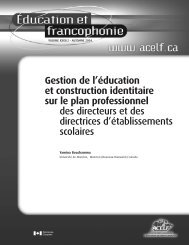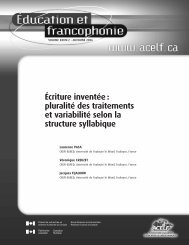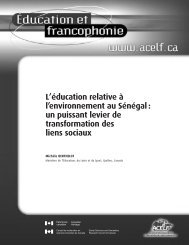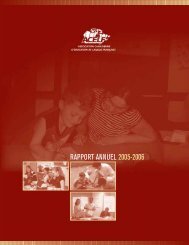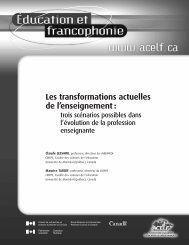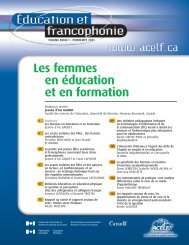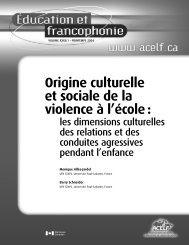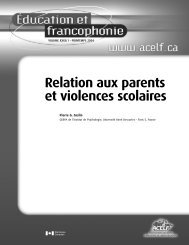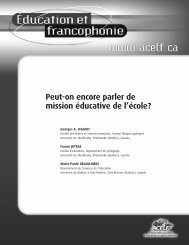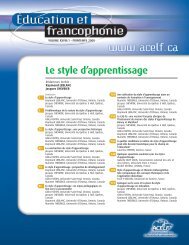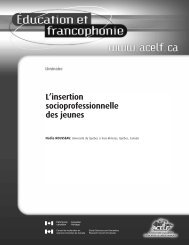Numéro complet (pdf) - acelf
Numéro complet (pdf) - acelf
Numéro complet (pdf) - acelf
You also want an ePaper? Increase the reach of your titles
YUMPU automatically turns print PDFs into web optimized ePapers that Google loves.
Les futurs enseignants confrontés aux TIC :<br />
changements dans l’attitude, la motivation et les pratiques pédagogiques<br />
ORNSTEIN, A.C. (1995). Strategies for Effective Teaching, Dubuque, IA : Brown &<br />
Benchmark Publishers, 2 e éd.<br />
PFEIFFER, L.C., FEATHERSTONE, H.J. (sans date). « Toto I don’t think we’re in<br />
Kansas anymore » : Entering the Land of Public Disagreement in Learning to<br />
Teach, East Lansing : National Center for Research on Teacher Learning,<br />
Michigan State University.<br />
PINTRICH, P.R., SCHRAUBEN, B. (1992). Students’ motivational beliefs and<br />
their cognitive engagement in classroom tasks. In Student Perceptions in<br />
the Classroom : Causes and Consequences, D. Schunk et J. Meece (dir.),<br />
Hillsdale, NJ : Erlbaum, p. 149-143.<br />
PINTRICH, P.R., SCHUNK, D.H. (1996). Motivation in Education, Englewood Cliffs,<br />
NJ : Prentice-Hall.<br />
PROCTOR, J.D., RICHARDSON, A.E. (1997). Evaluating the Effectiveness of<br />
Multimedia Computer Modules as Enrichment Exercises for Introductory<br />
Geography. In Journal of Geography in Higher Education, vol. 21 (1), p. 41-55.<br />
RELAN, A. (1992). Strategies in Computer-based Instruction : Some Lessons from<br />
Theories and Models of Motivation. In Proceedings of Selected Research and<br />
Development Presentations at the Convention of the Association for Educational<br />
Communications and Technology.<br />
RICHARDS, J.M. (1974). A simulation study comparing procedures for assessing<br />
individual educational growth, Center for Social Organization of Schools,<br />
Baltimore : The Johns Hopkins University.<br />
ROBERTSON, J. (1996). Promoting IT Competencies with Student Primary Teachers.<br />
In Journal of Computer Assisted Learning, vol. 12 (1), p. 2-9.<br />
RUSSELL, T.L. (1999). The no significant difference phenomenon, North Carolina :<br />
NCSU Office of Instructional Telecommunications.<br />
SAINT-ONGE, M. (1993). Moi j’enseigne, mais eux apprennent-ils? Laval (Québec) :<br />
Groupe Beauchemin.<br />
SAVOIE-ZAJC, L., KARSENTI, T. (2000). Méthodologie. In Introduction à la recherche<br />
en éducation, T. Karsenti et L. Savoie-Zajc (dir.), Sherbrooke : Éditions du CRP.<br />
SCHOLES, R., KARDASH, C.M. (1995). Graduate Students’ Perceptions of Volition<br />
Strategies Which Aid Persistence in Completing Degrees. In Annual Meeting of<br />
the American Educational Research Association, San Francisco, CA, 18-22 avril.<br />
SCHÖN, D.A. (1994). Le praticien réflexif : à la recherche du savoir caché dans l’agir<br />
professionnel, Montréal : Éditions Logiques.<br />
SCHUNK, D.H. (1991). Goal Setting and Self-Evaluation : A Social Cognitive<br />
Perspective on Self-Regulation. In Motivation and Achievement,<br />
M.L. Maehr et P.R. Pintrich (dir.), Greenwich, CT : JAI Press Inc.<br />
volume XXIX, printemps 2001<br />
122<br />
www.<strong>acelf</strong>.ca



